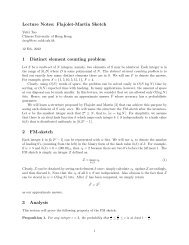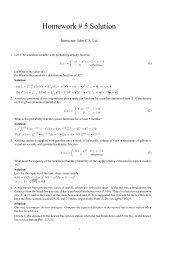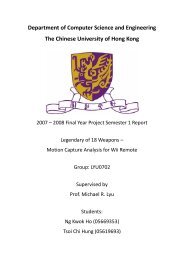Dynamic Bayesian Approach for Detecting Cheats in Multi-Player ...
Dynamic Bayesian Approach for Detecting Cheats in Multi-Player ...
Dynamic Bayesian Approach for Detecting Cheats in Multi-Player ...
You also want an ePaper? Increase the reach of your titles
YUMPU automatically turns print PDFs into web optimized ePapers that Google loves.
1<br />
2<br />
3<br />
4<br />
5<br />
6<br />
7<br />
8<br />
9<br />
10<br />
11<br />
12<br />
13<br />
14<br />
15<br />
16<br />
17<br />
18<br />
19<br />
20<br />
21<br />
22<br />
23<br />
24<br />
25<br />
26<br />
27<br />
28<br />
29<br />
30<br />
31<br />
32<br />
33<br />
34<br />
35<br />
36<br />
37<br />
38<br />
39<br />
40<br />
41<br />
42<br />
43<br />
44<br />
45<br />
46<br />
47<br />
48<br />
49<br />
50<br />
51<br />
52<br />
53<br />
54<br />
55<br />
56<br />
57<br />
58<br />
59<br />
60<br />
61<br />
62<br />
63<br />
64<br />
65<br />
10 S.F. Yeung, John C.S. Lui<br />
obta<strong>in</strong>ed directly, or derived from the game states conta<strong>in</strong>ed<br />
<strong>in</strong> the update packets by various players. For example, by<br />
compar<strong>in</strong>g the current position and the latest recorded position<br />
of a player, we know whether the player is mov<strong>in</strong>g<br />
or not. Dur<strong>in</strong>g a game session, a player will meet different<br />
targets <strong>in</strong> the virtual world, and it is very common to meet<br />
more than one target at the same time. We def<strong>in</strong>e a player’s<br />
current target as the latest target the player’s crosshair hov-<br />
ered over. To illustrate, let player A’s crosshair hovered over<br />
player B, then <strong>for</strong> player A, ˜<br />
TargetA = B until player A’s<br />
crosshair hovered over another player or player B became<br />
<strong>in</strong>visible to player A. The variables Distance (D) and Accuracy<br />
(A) are both derived aga<strong>in</strong>st this current target. Also, <strong>for</strong><br />
those random variables hav<strong>in</strong>g cont<strong>in</strong>uous values, i.e. Distance<br />
(D) and Accuracy (A), we discretize them <strong>in</strong>to a f<strong>in</strong>ite<br />
field. There<strong>for</strong>e, <strong>in</strong> tra<strong>in</strong><strong>in</strong>g the dynamic <strong>Bayesian</strong> network,<br />
we need to consider the follow<strong>in</strong>g random variables which<br />
take on the follow<strong>in</strong>g values:<br />
1. Cheat<strong>in</strong>g (C), with C ∈ [true, false],<br />
2. <strong>Player</strong> mov<strong>in</strong>g (M p ) with M p ∈ [true, false],<br />
3. Target mov<strong>in</strong>g (M t ) with M t ∈ [true, false],<br />
4. Mov<strong>in</strong>g crosshair (△P ), with △P ∈ [true, false],<br />
5. Distance from the aim<strong>in</strong>g target (D), with D ∈ [0, 1, 2, 3]<br />
<strong>in</strong> which larger the value implies further away is the distance,<br />
6. Change <strong>in</strong> D (△D), with △D ∈ [0, 1, 2, 3],<br />
7. Aim<strong>in</strong>g accuracy (A) with A ∈ [0, 1, 2, 3] <strong>in</strong> which the<br />
lower the value implies higher is the aim<strong>in</strong>g accuracy<br />
and,<br />
8. Change <strong>in</strong> A (△A) with △A ∈ [0, 1, 2, 3].<br />
Us<strong>in</strong>g these data, one can compute the follow<strong>in</strong>g prior<br />
probability distributions:<br />
1. P(Ct|Ct−1), and<br />
2. P(At|At−1, Ct, M p<br />
t , Mt t , Pt, Dt, △Dt, △At),<br />
Inferr<strong>in</strong>g the probability of cheat<strong>in</strong>g <strong>for</strong> any particular player<br />
follows the follow<strong>in</strong>g steps. At the very first time slice where<br />
t = 0, we <strong>in</strong>itialize P( ˜ C0 = true) to 0.5 (i.e., a player is<br />
equally likely to be a cheater or an honest player). For each<br />
time slice t, the <strong>in</strong>ference carries out <strong>in</strong> two stages:<br />
Stage 1: estimates the outcome of ˜ Ct based on Ct−1, ˜ this<br />
estimation can be carried out by the follow<strong>in</strong>g equation:<br />
P(C1 = T)<br />
= P(Ct = T |Ct−1 = T)P(Ct−1 = T)<br />
+P(Ct = T |Ct−1 = F)P(Ct−1 = F)<br />
Stage 2: updates ˜ Ct with all of the evidences at time slice t.<br />
This computation can be carried out by the follow<strong>in</strong>g equation:<br />
P(Ct = true|At, At−1, M p<br />
t , M t t,Pt, Dt, △Dt, △At)<br />
= P(at|at−1, Ct, m p<br />
t,m t t, pt, dt, △dt, △at)P(Ct = true)<br />
�false c=true P(at|at−1, Ct = c, m p<br />
t,m t t, △dt, dt)P(Ct = c) .<br />
The pseudo-code to per<strong>for</strong>m this <strong>in</strong>ference computation<br />
on the game server is as follows:<br />
Server Loop<br />
1. while (gameover == false) {<br />
2. <strong>for</strong> each player() {<br />
3. playerStates = receive player state update();<br />
// stage 1 computation based on Eq. (1)<br />
4. pPredict = cptCheat<strong>in</strong>g[cheat<strong>in</strong>g] * pCheat<strong>in</strong>g[t-1]<br />
+ cptCheat<strong>in</strong>g[!cheat<strong>in</strong>g] * (1.0 - pCheat<strong>in</strong>g[t-1]);<br />
// stage 2 computation based on Eq. (2)<br />
5. T = cptAccuracy[playerStates][cheat<strong>in</strong>g]<br />
* pPredict;<br />
6. F = cptAccuracy[playerStates][!cheat<strong>in</strong>g]<br />
* (1.0 - pPredict);<br />
7. pCheat<strong>in</strong>g[t] = T / (T + F);<br />
8. }<br />
9. timeframe++;<br />
10. }<br />
Computational Analysis: Based on the above pseudo-code,<br />
we see that to estimate the cheat<strong>in</strong>g probability, we require a<br />
total of n<strong>in</strong>e float<strong>in</strong>g po<strong>in</strong>t operations (from l<strong>in</strong>e 4 to l<strong>in</strong>e 8)<br />
per player with<strong>in</strong> each time slice. One can easily see that<br />
this is a light weighted computation. Assum<strong>in</strong>g that each<br />
time slice is 40 ms, i.e. 25 frames per second, this implies<br />
that to detect 100,000 simultaneous players, it only requires<br />
9 ∗25 ∗100, 000 = 22, 500, 000 float<strong>in</strong>g po<strong>in</strong>t operations per<br />
second. Us<strong>in</strong>g a P4 2.0GHz server as an example, which can<br />
per<strong>for</strong>m about one billion float<strong>in</strong>g po<strong>in</strong>t operations per second,<br />
there<strong>for</strong>e the overhead to detect 100,000 simultaneous<br />
players uses only 22.5% of the CPU capacity.<br />
For example, <strong>in</strong> commercial games such as counter-strike<br />
and Quake, the game clients send all commands (keyboard<br />
<strong>in</strong>puts) to the server. The server runs the simulation of the<br />
whole game because all game states must be authorized by<br />
the server be<strong>for</strong>e the server broadcasts the <strong>in</strong><strong>for</strong>mation to<br />
other players. There<strong>for</strong>e, the server already knows the position<br />
and the aim<strong>in</strong>g direction of all players at each <strong>in</strong>stance<br />
of the game. In our proposed method, the only additional<br />
computation requires to per<strong>for</strong>m prior to the <strong>Bayesian</strong> <strong>in</strong>ference<br />
rout<strong>in</strong>e is to compute the “distance between a player’s<br />
aim<strong>in</strong>g trajectory and the player’s current target”, i.e., the<br />
player’s accuracy. That is, to compute the distance between<br />
a po<strong>in</strong>t and a l<strong>in</strong>e which <strong>in</strong>volves a cross-product operation.<br />
Moreover, as we mentioned be<strong>for</strong>e, the computation only<br />
occurs when there is any visible target, and the server only<br />
needs to trace the accuracy with respect to the current target,<br />
until it is not visible to the player or their distance is<br />
beyond a certa<strong>in</strong> threshold. Also, <strong>for</strong> FPS games the number<br />
of players <strong>in</strong>volved <strong>in</strong> the same game session typically<br />
varies from 8 to 32. Hence, the computational overhead <strong>in</strong>duced<br />
should not be much. Moreover, <strong>in</strong> practical implementation<br />
one could create an <strong>in</strong>dividual queue to store a copy<br />
of the user states, and then carries out the computation of<br />
the player’s accuracy and also the <strong>Bayesian</strong> <strong>in</strong>ference rout<strong>in</strong>e<br />
<strong>in</strong> a computational thread, which is separated from the






